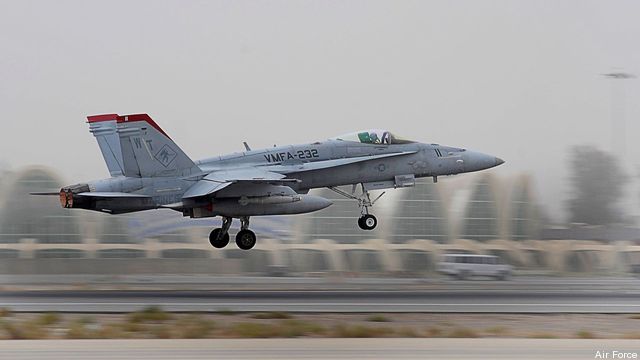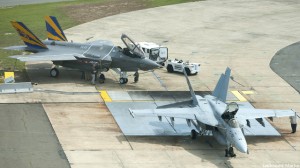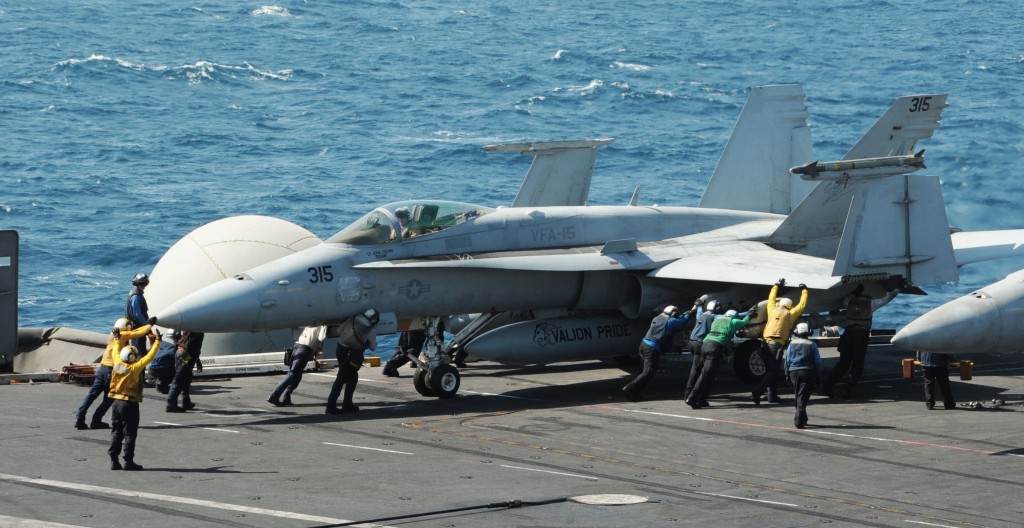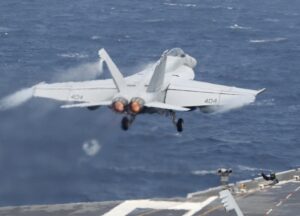Navy, Marine F-18s In ‘Death Spiral’ As Readiness Plummets
Posted on

Marine F-18 Hornet takes off from Kandahar Airfield in Afghanistan.
CAPITOL HILL: The Navy-Marine fighter fleet is in a “death spiral” and the only long-term fix is to buy new jets faster, both F/A-18E/F Super Hornets and the F-35 Joint Strike Fighter, a former Pentagon analyst told Breaking Defense. Two veteran Hill staffers agreed the situation is dire and new planes are needed, although they put equal emphasis on stable, adequate funding for maintenance.
The number of planes that are not ready for combat has gotten “very bad,” said one Hill staffer. “If there’s a big war, it’s a serious problem.”

A Navy F-35C and the plane it will replace, the F/A-18E Super Hornet, sit together on a runway.
Currently, 53 percent of Navy and Marine Corps aircraft are unfit to fly. That rises to 62 percent of strike fighters and, as we reported yesterday, 74 percent of Marine F-18 Hornets. Overused, under-maintained, and not replaced, the aircraft are simply wearing out.
“There will always be a portion of the fleet that will be out of reporting due to mods (modifications), depot maintenance, and other categories, but I think the historical norm is about a third,” said the second Hill staff. “Bottom line is the strike fighter situation is bad. I would say very bad.”
Why? First, the staffer said, “there has been a gutting of the aviation support accounts, (which) dropped to 52 percent of requirement in 2013” — the year sequestration sliced the Pentagon budget — “and (rose) only back up to 74 percent in 2015.”
Second, “consumption is outpacing procurement: Since 2000, we have struck 748 strike fighters and procured 573 for a delta (net loss) of 175 aircraft,” the staffer continued. More than half that net loss is due to delays on the Joint Strike Fighter program, the staffer added. “There were supposed to be something like 110 F-35Cs by 2018. Since they’re not there, the older aircraft get used up more.”
“What we are seeing is a classic death spiral,” said the former OSD analyst. “We have talked about this for years as being theoretically possible, but it never has actually happened. A platform death spiral occurs when you have too few of a given platform — airplanes, tanks, ships — but you continue to use them at the same or increased pace.” That creates a vicious circle. Fewer aircraft doing more work will wear out faster, which means you have even fewer aircraft working even harder, repeat at nauseam until the last plane breaks.
“The bottom line is that the naval air force is in a bad way,” said the analyst. “We need to continue producing JSFs to meet the high-end threats like SA-300/400s (advanced Russian-made anti-aircraft missiles) and reopen the Super Hornet line with Boeing to take pressure off the current force now.”

F/A-18C Hornet aboard USS George H.W. Bush
Deep Roots
The roots of today’s crisis trace back to the 1970s, when the Navy and Marines decided their new F-18 Hornets didn’t need the traditional protections against corrosion. They were wrong, as depot mechanics have repeatedly discovered on opening up early-model Hornets to discover time-consuming and unplanned-for problems.
The next fateful decision came in the 1990s, amidst the post-Cold War drawdown, when the Navy decided to buy fewer of the upgraded F/A-18E/F Super Hornets than planned and the Marine Corps decided not to buy them at all. Instead, the Marines resolved to keep their early-model Hornets — F/A-18As, Bs, Cs, and Ds — until the Joint Strike Fighter came along.

A Navy F/A-18 Super Hornet takes off from the aircraft carrier USS George Washington
Not only did the F-35 not arrive on schedule, but the post-Cold War peace didn’t last. Suddenly the services had to meet high wartime demand with a smaller and older fighter fleet than planned — which meant the aircraft were flown harder and wore out faster, triggering the death spiral.
In fact, the demand for aircraft over Iraq and Afghanistan was so intense that the services didn’t give the planes enough time in maintenance depots. “In order to meet high OPTEMPO (Operational Tempo) demands over the past 10-15 years, (they) skipped a lot of depot maintenance with F-18s or didn’t do all the work when they went to depot,” the first staffer said. “In short, they burned out the F-18 fleet and took shortcuts on maintenance. They did that to meet operational demands, which is certainly justifiable, but the cost for that is now coming due.”
Even as the need for maintenance grew, the budget for it got cut — particularly after the Budget Control Act passed in 2011. “The depots themselves have faced budget cuts, hiring freezes, etc. since 2011, which has reduced their throughput capacity. So, even if an F-18 is at a depot, it is taking much longer to get them through the process,” the first staffer continued. “The downward trend in O&M (Operations & Maintenance) funding, personnel cuts, and less spare parts funding has had an impact on the F-18 fleet’s readiness. If it takes longer to get parts, planes are going to be down longer. If you have fewer mechanics, it takes longer to fix everything.”
“To fix it, they mostly just need more O&M money over a sustained period of time, and it needs to be provided in a more predictable manner,” without BCA caps or Continuing Resolutions, the staffer said. “(But) a lot of the F-18s, especially in the USMC, are just plain old and worn out. No amount of maintenance can make a very old aircraft brand new.”
“The ways to get out of this are increase depot throughput, fully fund the enabler accounts, especially spares, (and) buy more new aircraft,” agreed the second staffer. “Procurement does help readiness.”
Subscribe to our newsletter
Promotions, new products and sales. Directly to your inbox.
